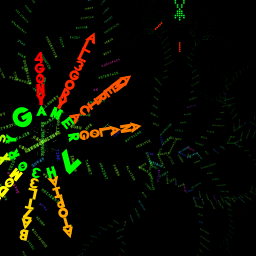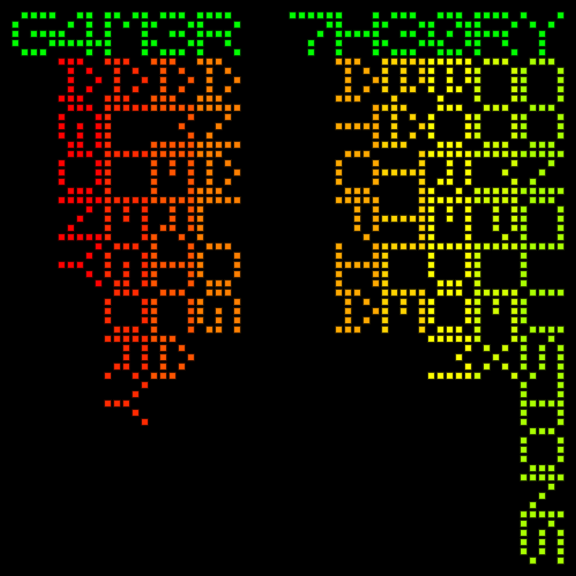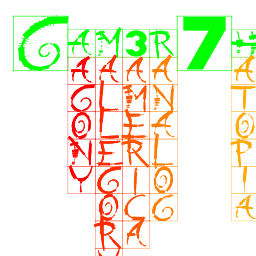Gamer Textually

Gamer Textually is a code artwork that generates visualizations and animations out of the text of the book “Gamer Theory” by McKenzie Wark. In the code, words become objects in a fractal space. Watch the animations and look at the large images to get a visceral sense of how the code ‘reads’ Wark’s work.
The code for Gamer Textually takes the form of a context free grammar which assembles artworks out of the original title, the table of contents, and the full source text of Wark’s “v1.1″ online manuscript. It also samples the cover logo art created by Tim Jones from the “v2.0″ print edition forthcoming from Harvard Press in April 2007. The code further imagines beyond Wark’s literal text, supposing myriad other combinatoric possibilities implied by Wark’s use of ‘leetspeak’, or letter-number substition.
Gamer Textually was created around one central question: How might a computer read Wark’s “Gamer Theory”? The answer takes the form of procedures or unit operations such as alphabetizing, ordering, coloring words by frequency of occurrence, etc. etc. However unlike a tag cloud or a histogram, which represents the statistical facts of a text, each Gamer Textually visualization represents one play session through the text – a series of chance encounters with various possible words structures, sensitive to initial conditions, always different and yet always the same.
Gamer Textually was written using Context Free, a cross-platform, open-source tool for visualizing context free grammars. It also builds on and synthesizes many contributions of the Context Free online community, including fonts and fractals featured in the credits. Work on Gamer Textually also inspired the development of a more general framework for digital text art, ConTextTree, forthcoming as an open source tool.
Gamer Texually in action
1. Contents and Alphebetization
One significant pattern that is machine-readable is the alphabetized table of contents. Why not a cover/title/table of contents that emphasizes both the structure of the work and the fact that it is ordered, like a file system directory?
2. Titles and Random Substitution
I found it interesting that the manuscript I was familiar with, “GAM3R 7H30RY,” (version 1.1) was appearing in book form as “Gamer Theory” (version 2.0). There are many reasons why this might be the case. Perhaps a not-insignificant one is the fact that the stereotypical hacker substitution schemes of 13375p34k (“leetspeak”) intentionally obscure the contents from normal readers, and further make it difficult for a book to be Googled or found on store shelves. Let’s see, what was that book called… Gam3r The0ry? 6amer 7heory? 64m3r 7#30ry?? Of course, for a computer, complex substitution schemes are a bit easier to read and write, so perhaps a computer visualization of the title could encompass ALL the potential titles, randomly choosing different letter combinations each time….
3. Letters and Algorithm
What about the letters themselves? What if they occurred as computational processes, not given, but emerging each time as a unique instance?
4. Space as Structure
Why not have the title and contents act like a structured and mutable object – like an element in a game, with spatial relations that implied not just a design space, but a play space?
5. Text and Tag Clouds
At this point I was ready to start engaging the text itself. I used word frequency analysis to create weighted lists of all the words in the text, as well as ordered lists of the top 100, 50, 25 etc. Rather than display a traditional tag cloud, with one instance of each word sized accordingly, I decided to fill the space using a fractal, coloring the words according to weight but otherwise allowing random selections and repetitions to fill the smaller and gaps.
6. Logos and Animation
The small logo from the front of the book design started to gain a new resonance for me – if the title was a structure, and the tag cloud was a space, then that small avatar might expect to enter Gamer Theory and interact. But this is a visualization, not a video game – I added an algorithm that randomly placed a variation on the logo at any one of many randomly selected angles of attack, depicting a computationally imagined superset implied by the one data point provided by the cover.
7. The Fractal Text
Integrating the idea of the title and logo as objects with the idea of the text as fractal space creates a unified image. Each random seed renders a completely different visualization, yet for all their differences they are all, in the end, the same.
About the Artist
Jeremy Douglass is an artist and scholar in the field of interactive fiction and electronic literature. His current projects explore the poetry of context free grammars, folders, passwords, and tag clouds. He is a Ph.D. candidate in English Literature at the University of California at Santa Barbara, and writes for the text art blog Writer Response Theory.
Credits and Licensing
Gamer Textually images and animations are available under Creative Commons Attribution Non-Commercial 2.5 licence – the same terms that restricted the artist’s original use of McKenzie Wark’s text under the Visualize This! remix event. To the extent that these images and animations are considered original remixes or fair use sampling, the artist disclaims all rights and releases them into to the public domain, useable for any purpose whatsoever.
Gamer Textually images and animations were all produced using Context Free. The final form draws on code libraries helpfully bundled with the application and generously shared on the Context Free gallery and forums, including:
- The included i_pix, snowflake, demo2
- Block Typeface by Bargonaut
- Lowercase Alphabe by dzeni
- AlFreeBet by Guigui
- Sierpinski in the city by mizukinakeshu
- tritree












